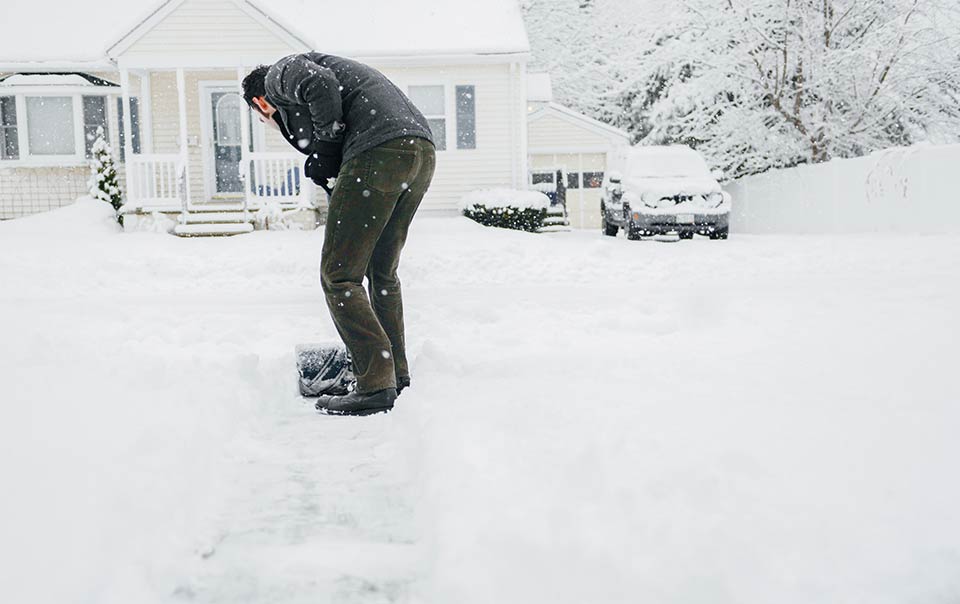Snow Shoveling Safety Tips
When the driveway and walkways are coated in a thick blanket of snow, it is time to get a shovel out for what some consider to be a dreaded chore. But before you tackle the first snowfall of the season, take some time to read these safety snow shoveling tips to help avoid any potential injuries.

Snow shoveling can lead to a number of health risks for many people, from back injuries to heart attacks. The mix of cold temperatures and physical exertion increases the workload on the heart,¹ which may increase the risk of a heart attack for some. According to the American Heart Association, even walking through heavy, wet snow can place strain on your heart.
The following tips can help keep you safer when you set out to shovel:
- Warm up. Warm your muscles before heading out to shovel by doing some light movements, such as bending side to side or walking in place.
- Push rather than lift. Pushing the snow with the shovel instead of lifting can help reduce the strain on your body. When lifting snow, bend your knees and use your legs when possible.
- Choose your shovel wisely. Ergonomically-designed shovels can help reduce the amount of bending you have to do.
- Lighten your load. Consider using a lighter-weight plastic shovel instead of a metal one to help decrease the weight being lifted.
- Hit the pause button. Pace yourself and be sure to take frequent breaks. Consider taking a break after 20 to 30 minutes of shoveling, especially when the snow is wet.
- Consider multiple trips. Consider shoveling periodically throughout the storm to avoid having to move large amounts of snow at once.
- Keep up with snowfall. Try to shovel snow shortly after it falls, when it is lighter and fluffier. The longer snow stays on the ground, the wetter it can become. Wet snow is heavier and harder to move.
- Wear layers. Dress in layers and remove them as you get warm to help maintain a comfortable body temperature.
- Stay hydrated. Drink plenty of water to stay hydrated while shoveling.
A national study² found that the most common shoveling-related injuries were to the lower back. Cardiac-related injuries account for only 7% of all injuries, but they were the most serious in nature. If you do not exercise on a regular basis, are middle-aged or older, or have any health conditions, such as heart disease or high blood pressure, you should check with your doctor before doing any strenuous shoveling. Consider using a snow blower or snow removal service as an alternative means of snow removal.
Snow and Ice Removal Requirements
Snow and ice not only pose a potential risk to you but also to others. As a property owner, you are responsible for making a reasonable effort to keep public walking areas around your property clear of snow and ice. Pre-treating your walkways and other paved surfaces with an anti-icing product can help make snow and ice removal easier.
Consider stocking up on ice melt in advance, as it sometimes sells out during long winters. You can store unused ice melt in an airtight container, out of reach from children and pets. Be aware that rock salt can damage brick, stone, asphalt and concrete walkways.
Be sure to check your local codes and ordinances regarding snow and ice removal requirements.
Sources:
¹ American Heart Association, http://www.heart.org/HEARTORG/Affiliate/Shoveling-Snow-Health-Hazards_UCM_426562_Article.jsp
² Nationwide Children's, http://www.nationwidechildrens.org/news-room-articles/new-national-study-finds-11500-emergency-department-visits-nearly-100-deaths-related-to-snow-shoveling-each-year?contentid=86424
I would like to acknowledge Travelers Canada for the publication of this article. This content was sourced on January 26, 2016.
 Snow shoveling can lead to a number of health risks for many people, from back injuries to heart attacks. The mix of cold temperatures and physical exertion increases the workload on the heart,¹ which may increase the risk of a heart attack for some. According to the American Heart Association, even walking through heavy, wet snow can place strain on your heart.
Snow shoveling can lead to a number of health risks for many people, from back injuries to heart attacks. The mix of cold temperatures and physical exertion increases the workload on the heart,¹ which may increase the risk of a heart attack for some. According to the American Heart Association, even walking through heavy, wet snow can place strain on your heart.